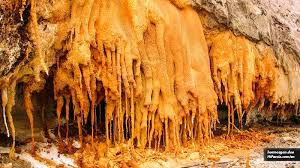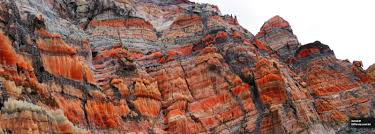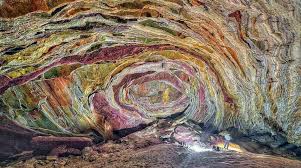 ثبت رایگان آگهی
ثبت رایگان آگهی What is a salt dome?
Where is the salt dome?
Iran's salt domes The salt dome, the most interesting phenomenon of world tourism and geotourism of the century, is one of the most amazing geological phenomena in which the buried layers of underground salts move towards the crust and then the surface of the earth due to geological movements and folds. They have a beautiful dome shape. These domes are mainly composed of two parts, the core and the surrounding covers. The core may be ore, salt, and even other minerals. For example, the core of some salt domes on the Gulf Coast of North America is sodium chloride and some calcium sulfate and other minerals. The core is covered with different layers of salt. These layers can show three different behaviors, they can rise, fall or remain unaffected and grow from the surrounding. The dome or anticline is clearly formed based on a pattern around the core and creates fault-like breaks. The structure of these domes is usually very large and the width of the salt cores varies between 2 and 5 miles.

How is a salt dome formed?
In the salt dome, several conditions such as melting point, freezing, density, pressure and temperature changes are effective in the formation of salts and ultimately the formation of salt dome masses. All this makes these mountains often more capable of forming in tropical regions. The beginning of the formation of the salt dome is the deposition of salt in sea and water ponds. Intense evaporation in tropical regions causes the deposition of more and more salt and the formation of evaporative sediments. During a long period of time, which sometimes even lasts several geological periods, salt masses are covered with sediments and are subjected to compression and pressure. Now, if this mass of salt is affected by a sudden vibration and fault, because it has a higher maximum pressure than the sediments covering it, it will move vertically towards the surface. The structure of the salt rock in the salt domes is such that it creates an impenetrable arch-like cavity inside it, and as a powerful natural structure, it can play a serious role as a storage tank for oil, natural gas, and sulfur. Soil and underground water make salt domes a suitable disposal site for all kinds of hazardous oil and chemical waste. These natural reservoirs act as a trap and trap toxic hydrocarbons and even nuclear waste and prevent dangerous and harmful environmental pollution.

Zagros salt dome
What is tourism in the salt dome?
Iran's salt domes The special geological structure of Iran has made it suitable for the formation of salt domes. The unbridled and folded zones of Zagros and the coasts of the Persian Gulf contain the densest salt domes in the country. The original natural images, amazing creativity of nature in the formation of domes and lanterns, glaciers and salt waterfalls have caused the salt domes to be considered as an attractive goal of geotourism. Among the most important salt domes in Iran, we can mention Jashak salt dome, Taghrud Qom salt dome and Hormozgan and Semnan salt domes. It is decorated in red and white.

The local people of the region believed that this salt mountain was the hideout and living place of demons and other supernatural and legendary creatures. The mood has come. This blue erosion has given a stunning pattern to this dome so that it can be considered one of the most beautiful works of geomorphological erosion.

The presence of this salt mountain causes the salinity of water and land in the region and limits the potential of covering plants such as goon and kich and its animals. The Mand river, which is drinkable and used for agriculture before reaching this area, becomes salty while passing through these salty lands.
The surface of this dome is covered with edible white salt, which makes this mountain look like a snow-covered peak from a distance. Next to this edible white salt, industrial salt candies in golden, red, brown, black, yellow and lemon colors will surprise the viewer. Glaciers, waterfalls, crystals and salt caves are among the unique scenes of this tourist area. There is also a wonderful valley known as Gol-Glam valley in this area, which is decorated with orange and white salts.

Salt dome of Taghrud Qom Salt dome of Qom
The Taghrud salt dome of Qom is one of the tourist attractions in the central part of Iran and is located 20 kilometers from Qom city towards Jafarieh district. Geologists believe that this salt mountain was formed by folding about 60 million years ago and its area is about 9 kilometers and its height is 3071 meters above sea level. The placement of this dome has made it known as the only symmetrical salt dome in the world. The crystals of these salts have taken a convoluted and blade shape and have created an interesting nature.
Where is the salt dome of Qom?
What distinguishes this salt complex from other domes is the existence of a salt lake in the middle of the hills and salt domes. The water of this lake has healing properties and one of the pleasures of it will be a bath and a salty bath. The water of the lake is very salty and clear, and in the hot seasons of the year, it faces high evaporation and special patterns of salt layers appear.
Among the other attractions of this area are the presence of red, brown, purple and cloudy salt crystals. Also, the presence of the salt caravanserai, which belongs to the Seljuk period, adds to the attractiveness of visiting this area.
This salt dome also had a mine, which has been suspended and closed due to the indiscriminate and unprincipled extraction as well as the damage it caused to the distinctive nature of this area, at the suggestion of Qom industry and mining activists.
Salt domes of Iran Hormuz salt dome Hormozgan province, due to its geological position and being on the faults and folds of the Great Zagros, many salt domes have been formed in it, one of which is the Hormoz salt dome. Hormuz Island, which is located 18 kilometers from Bandar Abbas city, is a residential and tourist island and one of the extraordinary salt domes of Iran and the world. This dome is formed by the folds of the Zagros mountain range in the waters of Farash Gulf. Throughout this island, you may come across anticlines and drifts that have different forms.
In addition to beauty, the salt rocks in this area are also sometimes used for food. One of the unique features of this salty island is its red soil, which, in addition to creating a tourist attraction, has a nutritional aspect for the native people of the region. It is used to prepare a variety of fish sauce.
In addition to having visual beauty and geo-tourism importance, salt domes are very important because of having a huge amount of minerals, therapeutic and even edible salt. Therefore, their protection is considered a vital and sacred matter for today's societies.

Author:
Maryam Pourhosseini MSc Stratigraphy and paleontology
Sangchein site - daily needs of the mining and equipment industry
